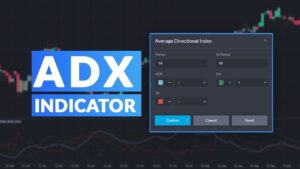The Dynamic Momentum Index (DMI) is a technical analysis tool designed to gauge the overbought or oversold conditions of an asset. It closely resembles the widely used Relative Strength Index (RSI), but with a key twist: DMI employs a variable timeframe in its calculations. This twist allows DMI to adapt to changing market volatility, potentially offering a more nuanced perspective for active traders.
Unveiling the DMI
Developed by Tushar Chande and Stanley Kroll in the early 1990s, the DMI borrows the core concept of the RSI – measuring the strength of recent price movements relative to past price action. However, unlike the RSI’s fixed timeframe (typically 14 periods), DMI dynamically adjusts the number of periods used based on the prevailing market volatility.
Here’s how it works:
- Dynamic Timeframe: DMI utilizes standard deviation to assess volatility. During periods of high volatility, the timeframe shrinks, making DMI more responsive to recent price swings. Conversely, in low volatility environments, the timeframe expands, allowing DMI to incorporate a broader historical price movement for a more balanced view.
- The Calculation: Similar to RSI, DMI calculates the Average Upward Price Change (AU) and Average Downward Price Change (AD) over the defined timeframe. These values are then used to compute the DMI itself, often displayed as a single line oscillating between 0 and 100.
DMI vs. RSI: A Tale of Two Indicators
While both DMI and RSI share the same goal of identifying overbought and oversold conditions, their core functionalities differ:
- Fixed vs. Flexible: RSI employs a fixed timeframe, making it less reactive to sudden changes in market volatility. DMI’s dynamic timeframe allows for quicker adaptation to evolving market conditions.
- Sensitivity: RSI’s fixed timeframe can lead to lagging signals in volatile markets. DMI’s dynamic nature provides potentially more timely signals during periods of high volatility.
- Trend Following: The fixed timeframe of RSI can make it less effective in identifying trend reversals. DMI’s adaptability might prove advantageous in capturing turning points in the market.
Interpreting the DMI
Similar to RSI, DMI readings are generally interpreted as follows:
- Below 30: Oversold territory, potentially indicating a buying opportunity.
- Above 70: Overbought territory, suggesting a potential selling opportunity.
However, it’s crucial to remember that these are just general thresholds. Market context and confirmation from other technical indicators are essential before making trading decisions based solely on DMI readings.
Utilizing the DMI for Better Trading Decisions
Here are some pointers for incorporating DMI into your trading strategy:
- Overbought/Oversold Signals: Look for DMI crossing above 70 (potential sell signal) in an uptrend or below 30 (potential buy signal) in a downtrend.
- Divergence: When price and DMI diverge, it might indicate a potential trend reversal. For instance, if the price keeps making new highs but DMI fails to follow suit, it could suggest weakening bullish momentum.
- Confirmation: Combine DMI signals with other technical indicators like support/resistance levels or moving averages for stronger confirmation before entering a trade.
Beyond the Basics: Advanced DMI Techniques
Seasoned traders can explore more advanced DMI applications:
- Variable Thresholds: The 30/70 thresholds are not set in stone. You can adjust them based on the asset class and historical volatility.
- Timeframe Considerations: While DMI adapts its timeframe automatically, you can experiment with using different base timeframes for the standard deviation calculation to fine-tune the indicator’s sensitivity.
Limitations of the DMI
No indicator is a perfect predictor of future price movements, and DMI is no exception. Here are some limitations to consider:
- False Signals: DMI, like other overbought/oversold indicators, can generate false signals, especially in choppy or range-bound markets.
- Volatility Dependence: DMI’s effectiveness hinges on accurately capturing market volatility. In unusually volatile or quiet periods, the indicator might provide less reliable signals.
- Over-reliance: DMI is just one tool in a trader’s toolbox. Avoid basing trading decisions solely on DMI readings.
The DMI – A Dynamic Ally for Active Traders
The Dynamic Momentum Index offers a valuable tool for active traders seeking to identify overbought/oversold conditions and potentially capitalize on trend reversals. Its dynamic nature allows for better adaptation to changing market volatility compared to the fixed timeframe of the RSI. However, remember that DMI is just one piece of the puzzle. Always use it in conjunction with other technical indicators, fundamental analysis, and proper risk management practices for informed trading decisions.
Beyond Technical: The Power of Combining Strategies
While DMI is a powerful technical analysis tool, successful trading involves a multi-pronged approach. Here’s how DMI can complement other aspects of your trading strategy:
- Fundamental Analysis: Understanding the underlying fundamentals affecting an asset (e.g., company earnings, economic data) can add context to DMI signals. A strong company with solid fundamentals might be a better buying opportunity even if the DMI suggests an oversold condition.
- Price Action: Analyzing price action alongside DMI readings can provide valuable insights. For example, a bullish engulfing candlestick pattern appearing at a DMI oversold reading might strengthen the case for a potential trend reversal.
- Risk Management: DMI should not dictate your entire trade plan. Always implement proper risk management techniques, such as stop-loss orders, to limit potential losses regardless of the DMI signal.
The Final Word: Embracing Continuous Learning
The financial markets are dynamic and constantly evolving. As a trader, it’s crucial to continuously learn and adapt your strategies. Backtesting DMI with historical data on your preferred asset classes can help you understand its effectiveness and identify potential shortcomings. Additionally, exploring other technical indicators and fundamental analysis techniques will further equip you to navigate the complex world of trading.
By incorporating the DMI into your trading toolkit with a critical and well-rounded approach, you can potentially gain a valuable edge in identifying trading opportunities and making informed decisions. Remember, success in trading requires discipline, patience, and a commitment to continuous learning.
Let’s Manage Your Forex Funds With Fx Pips Guru!
Fx Pips Guru is a forex fund management company managing client’s funds based on monthly profit share. Let’s do Live Chat with our experts.




